
Carl Spitzweg was a German romantic painter, especially of genre subjects. He is considered to be one of the most important artists of the Biedermeier era.

Stairs are a structure designed to bridge a large vertical distance between lower and higher levels by dividing it into smaller vertical distances. This is achieved as a diagonal series of horizontal platforms called steps which enable passage to the other level by stepping from one to another step in turn. Steps are very typically rectangular. Stairs may be straight, round, or may consist of two or more straight pieces connected at angles.

Rudolf August Oetker colloquially also R.A. Oetker was a German industrialist, businessman, ship owner and philanthropist. Most notably he turned Dr. Oetker, founded by his grandfather August Oetker, into a multinational food conglomerate. During World War II, Oetker was a member of the Nazi Party.

The Lenbachhaus is a building housing the Städtische Galerie art museum in Munich's Kunstareal.

The Old Vanderburgh County Courthouse, often simply called the "Old Courthouse," was once the center of Vanderburgh County, Indiana government. Construction started in the spring of 1888 and was completed in November 1890. The building was ready to be occupied by the county government in early 1891. It sits in the heart of downtown Evansville.
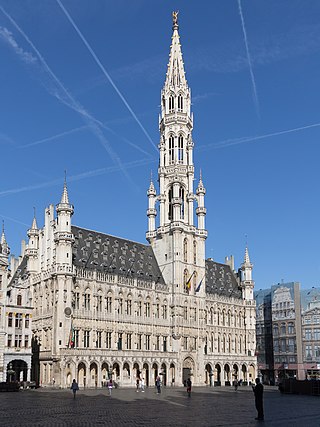
The Town Hall of the City of Brussels is a landmark building and the seat of the City of Brussels municipality of Brussels, Belgium. It is located on the south side of the famous Grand-Place/Grote Markt, opposite the neo-Gothic King's House or Bread House building, housing the Brussels City Museum.

The Bookworm is an oil-on-canvas painting by the German painter and poet Carl Spitzweg. The picture was made c. 1850 and is typical of Spitzweg's humorous, anecdotal style and it is characteristic of Biedermeier art in general. The painting is representative of the introspective and conservative mood in Europe during the period between the end of the Napoleonic Wars and the revolutions of 1848, but at the same time pokes fun at those attitudes by embodying them in the fusty old scholar unconcerned with the affairs of the mundane world.
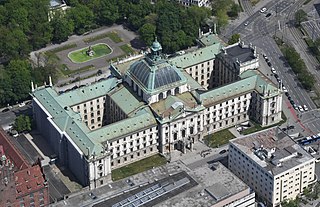
The Justizpalast Munich are two courthouses and administrative buildings in Munich.

Lady Justice is an allegorical personification of the moral force in judicial systems. Her attributes are scales, a sword and sometimes a blindfold. She often appears as a pair with Prudentia.

The Museum Georg Schäfer is a German art museum in Schweinfurt, Bavaria. Based on the private art collection of German industrialist Georg Schäfer (1896–1975), the museum primarily collects 19th-century paintings by artists from German-speaking countries.
Kites is an oil on card painting by Carl Spitzweg, executed in 1880–1885, now in the Alte Nationalgalerie in Berlin, which acquired it from the Fritz Gurlitt gallery in Berlin, in 1908.
Rudolph J. Heinemann, also known as Rudolf J. Heinemann, was a German-born American art dealer and collector of Old Masters. He was an advisor to Baron Hans Heinrich Thyssen-Bornemisza, who established a museum in Lugano, Switzerland with his help. Heinemann and later, his wife Lore, donated works of art to the Metropolitan Museum of Art, the Frick Collection, the National Gallery of Art and the Morgan Library & Museum.
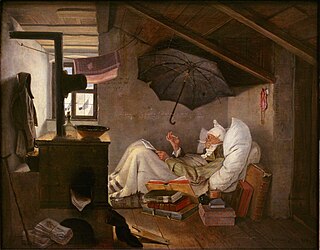
The Poor Poet is the best known and most popular painting by German painter Carl Spitzweg. It was executed in 1839 and had three versions.
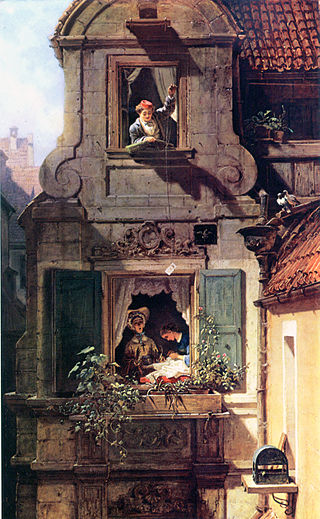
The Intercepted Love Letter is an oil-on-canvas painting by German painter Carl Spitzweg. It was painted c. 1860 and its now housed at the Museum Georg Schäfer, in Schweinfurt, Germany.

Rue Saint-Honoré, dans l'après-midi. Effet de pluie is an 1897 oil painting by Camille Pissarro. The work was made towards the end of Pissarro's career, when he abandoned his experiments with Pointillism and returned to a looser Impressionist style. It is part of a series of works that Pissarro made in 1897-98 from a window of the Hôtel du Louvre, looking down across the edge of the place du Théâtre Français and along the rue Saint-Honoré, portraying the people, carriages and buildings, the trees, fountains and streetlamps, in an early afternoon shower of rain. Other paintings in the series depict a similar scene in morning sunlight, or in the shadows of the evening. The painting measures 81 cm × 65 cm.

Leo Bendel was an Austrian-born German Jewish tobacco dealer and art collector.

The Geologist is an glue paint on paper on canvas painting by the German painter Carl Spitzweg executed c. 1860. It belongs to the collection of the Von der Heydt Museum in Wuppertal, to which it was bequeathed in 1913. Spitzweg's style of painting belongs to the late Romantic period.

Departure is an oil-on-canvas triptych by German artist Max Beckmann begun in Frankfurt in 1932 and completed in Berlin from 1933 to 1935. It was the first of nine triptychs that the artist created. The panels, according to Beckmann, are named The Castle (left), The Homecoming (middle) and The Staircase (right). The paintings have all the same height and the middle panel, with 115 cm, is only slightly wider than the other two, which have 99.5 cm in length. It is one of his best-known triptychs and is held at the Museum of Modern Art, in New York.
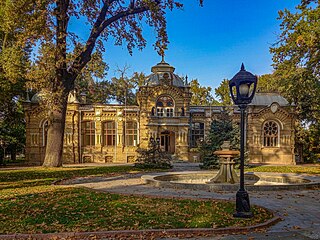
The Romanov Palace, located in Tashkent, Uzbekistan, was built in 1891 according to the design of architect V.S Geintselman and A.L. Benois for Grand Duke Nikolai Konstantinovich, who had been exiled to the outskirts of the empire in the Turkestan region. The left wing of the palace housed the apartments of the Grand Duke, and the right-wing housed the apartments of his wife. Currently, the building is used as a reception house for the Ministry of Foreign Affairs of Uzbekistan. Near the entrance to the palace grounds, there used to be the Iosifo-Georgievskaya Church until 1995.

The Warlock, also known as The Wizard and the Dragon, is the title of two oil on canvas paintings by German painter Carl Spitzweg, from 1875 and 1880. The original painting is now held in the Museum Georg Schäfer, in Schweinfurt, while the other is in a private collection. The two paintings are almost identical in motif but differ in size and color.


















